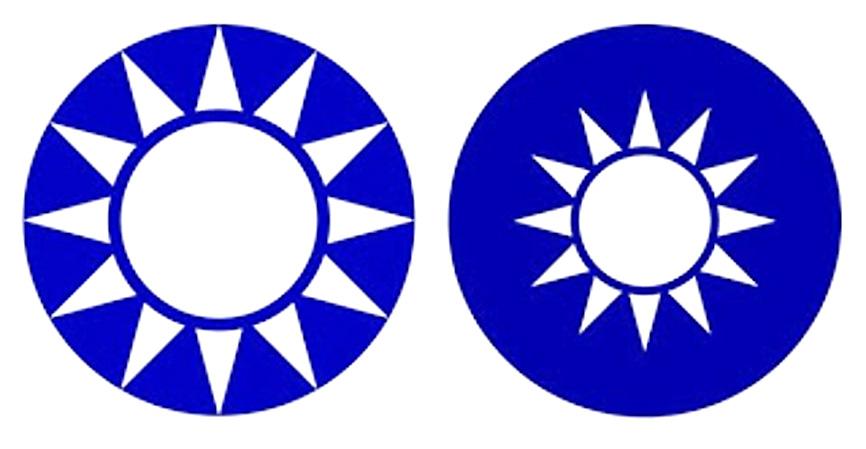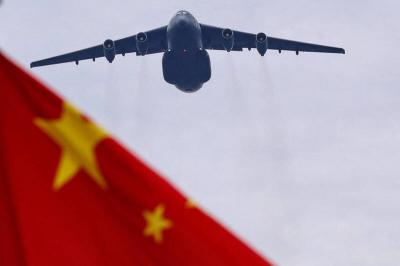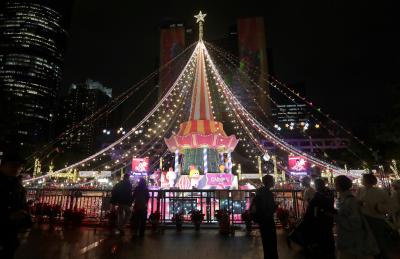Changing the national emblem should not be taken lightly, as it embodies the nation’s collective sentiment, but political party symbols can and should change with the times, the Ministry of the Interior said on Thursday in a report on the issues stemming from similarities between the national and Chinese Nationalist Party (KMT) emblems.
The ministry issued the report in response to a motion raised by the New Power Party caucus and passed on Jan. 29 requesting an evaluation within two months.
Since its installment in 1928, the national emblem has been broadly applied on the national and military flags, medals, uniforms, certificates, foreign embassies and other places, it said.

Photo: Chen Yu-fu, Taipei Times
Changing the emblem would involve difficult legal amendments and considerable expense to redesign all of the aforementioned applications, it said.
The ideological strife it would exacerbate is also a concern, potentially spilling over into the nation’s international dealings, the report added.
The nation went through a long period of authoritarian rule that erased the lines between party and state, but has been lauded the world over for its transition to democracy, earning it the moniker “the beacon of democracy in Asia,” it said.
Although the similarity between the national and KMT emblems is based in history, the national emblem is a symbol of the nation and changing it should not be considered lightly, the ministry said.
On the other hand, the symbols of political parties can and should change to reflect current sentiment, it said.
The party-state era is over and the political arena has become diversified, so political symbols should change to respect the national emblem, it added.
In response, KMT Chairman Johnny Chiang (江啟臣) wrote on Facebook that the suggestion was a deliberate attempt by the Democratic Progressive Party (DPP) to shift the public’s focus from the deadly train accident in Hualien County on Friday last week, claiming the lives of 50 people and injuring more than 200 others.
Taking up the issue is a scheme on the DPP’s part to shift the public’s attention from the tragedy and to dodge its responsibility, which is a disgrace to those who perished in the accident and their families, Chiang said.
He also questioned the DPP’s loyalty to the nation, its flag and the national emblem.
“If the DPP fully identifies with the Republic of China, the KMT will be happy to see it incorporate elements of the national flag and national emblem into its party emblem,” he said.
Deputy Minister of the Interior Chen Tsung-yen (陳宗彥) yesterday said the report only offers an analysis of the current situation and is not a demand for any political party to change their party emblem.

Beijing could eventually see a full amphibious invasion of Taiwan as the only "prudent" way to bring about unification, the US Department of Defense said in a newly released annual report to Congress. The Pentagon's "Annual Report to Congress: Military and Security Developments Involving the People's Republic of China 2025," was in many ways similar to last year’s report but reorganized the analysis of the options China has to take over Taiwan. Generally, according to the report, Chinese leaders view the People's Liberation Army's (PLA) capabilities for a Taiwan campaign as improving, but they remain uncertain about its readiness to successfully seize

Taiwan is getting a day off on Christmas for the first time in 25 years. The change comes after opposition parties passed a law earlier this year to add or restore five public holidays, including Constitution Day, which falls on today, Dec. 25. The day marks the 1947 adoption of the constitution of the Republic of China, as the government in Taipei is formally known. Back then the Chinese Nationalist Party (KMT) governed China from Nanjing. When the KMT, now an opposition party in Taiwan, passed the legislation on holidays, it said that they would help “commemorate the history of national development.” That

Taiwan has overtaken South Korea this year in per capita income for the first time in 23 years, IMF data showed. Per capita income is a nation’s GDP divided by the total population, used to compare average wealth levels across countries. Taiwan also beat Japan this year on per capita income, after surpassing it for the first time last year, US magazine Newsweek reported yesterday. Across Asia, Taiwan ranked fourth for per capita income at US$37,827 this year due to sustained economic growth, the report said. In the top three spots were Singapore, Macau and Hong Kong, it said. South

Snow fell on Yushan (Jade Mountain, 玉山) yesterday morning as a continental cold air mass sent temperatures below freezing on Taiwan’s tallest peak, the Central Weather Administration (CWA) said. Snowflakes were seen on Yushan’s north peak from 6:28am to 6:38am, but they did not fully cover the ground and no accumulation was recorded, the CWA said. As of 7:42am, the lowest temperature recorded across Taiwan was minus-5.5°C at Yushan’s Fengkou observatory and minus-4.7°C at the Yushan observatory, CWA data showed. On Hehuanshan (合歡山) in Nantou County, a low of 1.3°C was recorded at 6:39pm, when ice pellets fell at Songsyue Lodge (松雪樓), a